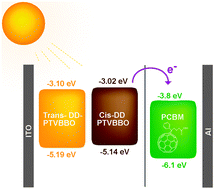Synthesis, characterization and photovoltaic properties of poly(thiophenevinylene-alt-benzobisoxazole)s†‡
Abstract
Herein we report the synthesis of two solution processible,

* Corresponding authors
a
Department of Chemistry, Iowa State University, Ames, USA
E-mail:
malikaj@iastate.edu
Fax: +1 515-294-0105
b Department of Electrical Engineering, Iowa State University, Ames, USA
c Department of Chemistry, North Georgia College & State University, USA
Herein we report the synthesis of two solution processible,

 Please wait while we load your content...
Something went wrong. Try again?
Please wait while we load your content...
Something went wrong. Try again?
J. F. Mike, K. Nalwa, A. J. Makowski, D. Putnam, A. L. Tomlinson, S. Chaudhary and M. Jeffries-EL, Phys. Chem. Chem. Phys., 2011, 13, 1338 DOI: 10.1039/C0CP00353K
To request permission to reproduce material from this article, please go to the Copyright Clearance Center request page.
If you are an author contributing to an RSC publication, you do not need to request permission provided correct acknowledgement is given.
If you are the author of this article, you do not need to request permission to reproduce figures and diagrams provided correct acknowledgement is given. If you want to reproduce the whole article in a third-party publication (excluding your thesis/dissertation for which permission is not required) please go to the Copyright Clearance Center request page.
Read more about how to correctly acknowledge RSC content.
 Fetching data from CrossRef.
Fetching data from CrossRef.
This may take some time to load.
Loading related content
